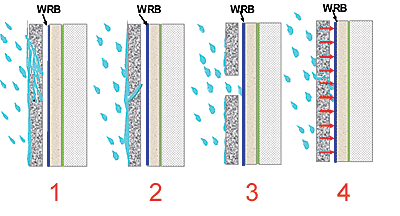Moisture Management in Wall Assemblies: Air, Water, and Vapor Barriers
Bulk Water Transport Through The Bulding Enclosure
Rain is the main water source for above grade walls. Rain can penetrate behind cladding and into the building enclosure through any openings, cracks and gaps in the assembly, and accumulate inside the wall cavity. The main mechanisms for bulk water intrusion include gravity, capillary action, kinetic energy of rain driven droplets, and pressure differential.
There are two basic approaches for rain penetration control: control the driving forces across the openings or eliminate the openings. The first approach includes proper sloping to the outside (gravity drainage to outside), capillary break (to control capillary action), shielding the openings (to control rain penetration due to kinetic energy), and pressure equalized rain screen walls (to control pressure differential across the envelope).
Water intrusion mechanisms through above grade wall assemblies |
 1. Gravity: can draw water down through opening and cracks 2. Capillary Action: sucks water through small cracks & pores 3. Rain Droplets: falling rain can pass through openings 4. Pressure Differential: can push or suck water through cracks |
The second approach consists of eliminating the openings. This can be achieved through a face-seal design, which is difficult to achieve, due to sealants exposure and extensive maintenance requirements, or by using a secondary line of defense, such as a water-resistant barrier.
Water-Resistant Barriers
Water-Resistant Barriers are materials specifically designed to protect against rain penetration and prevent water leakage into the building interior. Water-resistant barriers, also referred to as the drainage plane, are typically installed behind cladding for the two main types of wall assemblies, cavity insulation and exterior insulation.
In wall assemblies with insulation inside stud cavity, the water-resistant barrier is typically installed on the exterior face of the exterior sheathing. In exterior insulation walls, the water-resistant barrier can be either sandwiched between the exterior sheathing and the exterior rigid insulation(1), or outside of the exterior rigid insulation(2). The former is the most common installation, while the latter should be used for insulation materials that are sensitive to water.
Typical position within the building envelope for water-resistant barriers |
 |
Codes and Performance Requirements
The 2006 International Building Code (IBC) requires that water-resistant barriers be used and installed to provide a continuous drainage plane and drainage pathways to the outside of the building envelope, including weep holes and through-wall flashing. The following excerpts apply:
Section 1403.2. Weather protection: The exterior wall envelope shall be designed and constructed so as to prevent the accumulation of water within the wall assembly by providing a water-resistive barrier behind the exterior veneer, as described in Section 1404.2, and a means for draining water that enters the assembly to the exterior.
Section 1404.2. Water-resistive barrier:A minimum of one layer of No. 15 asphalt felt, complying with American Society for Standards and Materials (ASTM) D226 for Type 1 felt or other approved materials, shall be attached to the studs or sheathing, with flashing as described in Section 1405.3, so as to provide a continuous water-resistive barrier behind the exterior wall veneer.
Section 1405.3 Flashing: Flashing shall be installed in such a manner so as to prevent moisture from entering the wall or to redirect it to the exterior.









